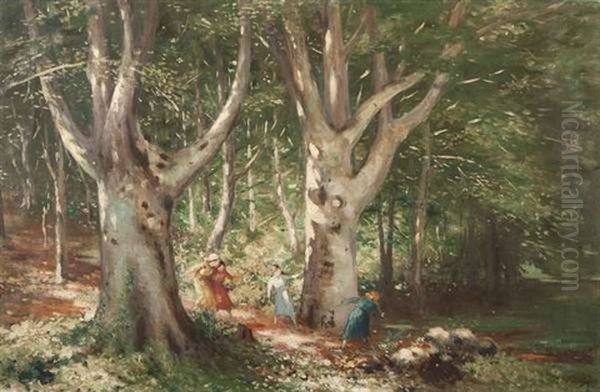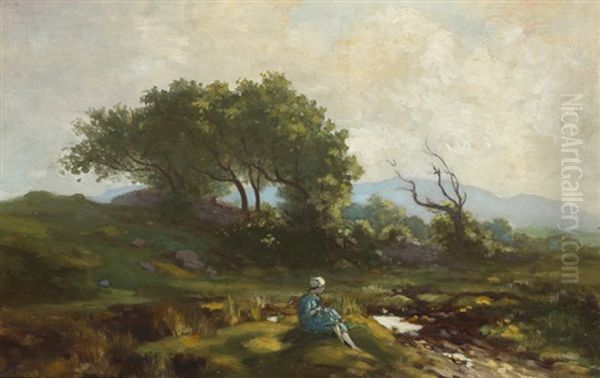
George William Russell, far better known by his enigmatic pseudonym "AE," stands as a unique and pivotal figure in the cultural landscape of late nineteenth and early twentieth-century Ireland. Born in Lurgan, County Armagh, on April 10, 1867, Russell's life (1867-1935) encompassed a remarkable range of activities. He was not only a significant painter but also a highly regarded poet, a profound mystic, an influential editor, a writer on economics and politics, and a key architect of the Irish Agricultural Organisation Society (IAOS). His identity was unequivocally Irish, and his life's work was deeply intertwined with the aspirations and spiritual explorations of his nation during a period of intense cultural and political ferment.
His family relocated to Dublin when he was eleven, a move that proved decisive for his future development. Dublin would become the crucible for his intellectual, artistic, and spiritual awakening. His formal education included periods at Rathmines School and the Metropolitan School of Art in Dublin. It was during his time at art school, around 1884, that he forged one of the most significant relationships of his life: a lifelong friendship with the poet William Butler Yeats. This connection would place both men at the very heart of the burgeoning Irish Literary Revival.
Early Life and Mystical Awakenings
Russell's upbringing in Lurgan, particularly his experiences near the demesne of Brownlow House, seems to have instilled in him a deep sensitivity to the natural world and perhaps laid the groundwork for his later mystical inclinations. The provided texts note that even from childhood, Russell experienced premonitions and visionary states. These were not fleeting occurrences but persistent phenomena that profoundly shaped his worldview and artistic output throughout his life. He perceived the veil between the seen and unseen worlds as thin, a conviction that would become central to his identity as both a mystic and an artist.

His move to Dublin exposed him to new intellectual currents. Alongside Yeats, he became deeply involved in the study of mysticism, Eastern religions, and esoteric philosophies. Theosophy, as promulgated by figures like Madame Blavatsky, held a particular fascination for many intellectuals and artists of the era, including Russell and Yeats. They explored Hermeticism, Platonism, and ancient Irish mythology, seeking spiritual truths and a deeper understanding of existence beyond the purely material. These explorations were not merely academic; Russell actively cultivated his visionary capacity, reporting experiences of seeing spiritual beings and landscapes from other times and dimensions.
The Genesis of "AE"
The adoption of his famous pseudonym, "AE," is itself a curious anecdote rooted in his early writing career. He had initially signed some writings with the word "Aeon," signifying an age or a timeless spiritual entity. According to accounts, a printer or proofreader, unable to decipher the full word, queried it. Russell suggested shortening it to just the first two letters, "AE." This seemingly accidental moniker stuck, becoming the name under which he achieved widespread recognition. It perfectly encapsulated the timeless, spiritual dimension he sought to explore in his life and work, hinting at the ancient wisdom and eternal principles that fascinated him.
This pseudonym became synonymous with a particular strand of Irish thought – one that blended nationalism with a deep spiritual quest, looking to Ireland's ancient past and mystical traditions as sources of inspiration and renewal. It distinguished him even within the diverse group of figures involved in the Irish Revival, marking him as a seer and visionary as much as a writer or painter.
Artistic Development and Style: Painting the Unseen
Although he pursued various careers, including a lengthy stint working for the Irish Agricultural Organisation Society, painting remained a constant and vital form of expression for Russell. His training at the Metropolitan School of Art provided him with a technical foundation, but his artistic vision was primarily driven by his inner life and mystical experiences. His style is often described as dreamlike, ethereal, and deeply imbued with a sense of spiritual presence. He sought to depict not just the physical appearance of the Irish landscape but its soul, its hidden life, and the spiritual entities he believed inhabited it.

His paintings often feature luminous, otherworldly light and vibrant, sometimes non-naturalistic, colour palettes. Figures, whether human or supernatural, tend to possess a certain grace and remoteness, appearing as inhabitants of a realm just beyond ordinary perception. Unlike the more objective or socially focused realism of some contemporaries like William Orpen or the romantic, yet grounded, landscapes of Paul Henry, AE's work consistently aimed for the transcendental. His art shares affinities with the broader European Symbolist movement, seen in the work of artists like Gustave Moreau or Odilon Redon, who also explored themes of myth, dream, and the inner world.
AE often painted landscapes, particularly those of Donegal, which held a special spiritual significance for him. However, these were rarely straightforward topographical representations. Instead, they became stages for visionary encounters, populated by ethereal beings, nature spirits, or figures absorbed in contemplation. His work frequently features children, depicted not merely sentimentally but as beings closer to the spiritual source, embodying innocence and a natural connection to the unseen. The painting Children Playing in Woodland Glade exemplifies this theme, capturing a sense of enchantment and harmony between the figures and their sylvan surroundings.
Themes in AE's Art: Nature, Myth, and the Spirit World
The core themes in AE's visual art are inextricably linked to his mystical beliefs and his deep love for Ireland. Nature was paramount, seen not as mere scenery but as a living entity pulsating with spiritual energy. He painted the hills, lakes, and coasts of Ireland, often focusing on places like Howth or the landscapes of the west, seeking to capture moments of transcendent beauty and revelation. Summer Evening, Sun on Hill of Howth likely captures this focus on light and atmosphere transforming a familiar scene into something magical.
Mythology, particularly Irish mythology, provided another rich vein of inspiration. Like Yeats, AE saw the ancient myths not as dead stories but as living repositories of spiritual wisdom and national identity. His paintings sometimes allude to figures or scenes from these myths, reimagining them through his own visionary lens. This connected his work directly to the aims of the Irish Revival, which sought to reclaim and revitalize Ireland's pre-colonial cultural heritage.
Perhaps most distinctively, AE painted his visions. He claimed to see elemental beings, nature spirits (often referred to as Sidhe or 'faeries' in Irish tradition, though his conception was more theosophical), and what he termed "Aeons" – luminous, god-like figures from higher spiritual planes. These beings often appear in his landscapes, sometimes interacting with human figures, sometimes simply present as shimmering forms of light and colour. The painting Contemplation likely reflects this inward focus, depicting a figure perhaps communing with these inner or outer spiritual realities. His work Women and children bathing in the shady forest lake probably combines his love for natural settings with depictions of figures in moments of serene connection with nature.
AE and the Irish Literary Revival
While this discussion focuses on AE as a painter, his role in the Irish Literary Revival cannot be overstated, and his activities were interconnected. He was a central figure from the movement's inception, a close confidant and sometimes counterpoint to W.B. Yeats. His first book of poems, Homeward: Songs by the Way (1894), was a landmark publication, establishing his reputation as a poet of mystical insight and lyrical grace. Its success helped define the spiritual and nationalistic tenor of the Revival.
AE's home became a regular meeting place for writers, artists, and thinkers, fostering discussion and collaboration. He was a generous mentor to younger writers, including figures like Padraic Colum and James Stephens, using his editorial positions to promote their work. He served as editor of The Irish Homestead (the journal of the IAOS) from 1905 to 1923, and later of its successor, The Irish Statesman, until 1930. Through these publications, he not only advocated for agricultural cooperation but also provided a platform for a wide range of cultural and political discourse, shaping public opinion and nurturing literary talent.
His relationship with Yeats was complex and enduring. They shared deep interests in the occult, Theosophy, and Irish folklore, collaborating on early projects related to the Dublin Hermetic Society. While Yeats increasingly focused on poetry and drama, eventually winning the Nobel Prize, AE maintained his diverse portfolio of activities. Some sources suggest AE's evident talent in painting may have even encouraged Yeats to concentrate more fully on his own primary medium of poetry. Though their paths sometimes diverged, their mutual respect and influence remained a constant throughout their lives. He was also involved in the early stages of the Irish National Theatre Society, which later became the famed Abbey Theatre, associating with figures like the Fay brothers.
The Practical Mystic: Agriculture and Economics
AE's deep involvement with Sir Horace Plunkett's Irish Agricultural Organisation Society (IAOS) might seem incongruous with his mystical inclinations, but for AE, they were complementary. He joined the IAOS in 1897, working tirelessly for decades as an organiser and later as Assistant Secretary and editor of its journal. He believed passionately in the cooperative movement as a means of empowering rural Ireland, fostering self-reliance, and building a more just and prosperous society.
His work involved extensive travel throughout Ireland, organising cooperative banks and creameries, and advocating for better farming practices. This practical engagement with the lives of ordinary Irish people grounded his idealism. He saw the revitalisation of rural Ireland as essential to the nation's spiritual and cultural health. His writings on economics and rural development were widely read and respected, demonstrating a pragmatic side that balanced his visionary pursuits. For AE, the spiritual and the material were interconnected; building a better Ireland required attention to both its soul and its soil.
AE in the Wider Art World: Recognition and Context
Despite his multifaceted career, AE achieved significant recognition as a painter during his lifetime. He exhibited regularly in Dublin, often at venues associated with the Revival movement. His reputation extended beyond Ireland; notably, he was invited to exhibit at the landmark Armory Show in New York in 1913. This hugely influential exhibition introduced American audiences to European modernism, featuring works by avant-garde masters like Marcel Duchamp, Constantin Brancusi, and Henri Matisse, alongside established figures like Claude Monet, Auguste Renoir, Paul Cézanne, and Vincent van Gogh. AE's inclusion alongside such company indicates the esteem in which his unique visionary art was held internationally at the time.
The influential Irish-American lawyer and collector John Quinn, a major patron of modern art (including works by Picasso and Joyce), also recognized AE's talent and sought patrons for his paintings in the United States. Within Ireland, he was considered one of the foremost painters of his generation, alongside figures like Jack B. Yeats (W.B.'s brother, known for his expressive depictions of Irish life), the aforementioned Paul Henry and William Orpen, the society portraitist John Lavery, and the landscape painter Nathaniel Hone the Younger. His work offered a distinct alternative to the more academic styles or the burgeoning modernist experiments of artists like Mainie Jellett and Evie Hone, who explored Cubism and abstraction later in AE's career. His spiritual focus might also distantly echo the visionary art of earlier figures like William Blake. While direct collaborations with specific painters aren't heavily documented, his participation in exhibitions and his central role in Dublin's cultural life ensured he was a known and respected figure within the Irish artistic community, even if his primary focus wasn't solely on painting. His influence might be compared to that of other Symbolist-influenced painters like the Belgian Fernand Khnopff or the Swiss Arnold Böcklin in their respective national contexts.
Later Life, Legacy, and Evaluation
AE remained a prominent figure in Irish life through the turbulent years of the War of Independence and the establishment of the Irish Free State. He continued to write, paint, and lecture, advocating for peace, cooperation, and his vision of a spiritually awakened Ireland. Following the death of his wife, Violet, in 1932 and the cessation of The Irish Statesman, he felt increasingly disconnected from the direction Ireland was taking and spent more time abroad, particularly in England and the United States, where he undertook lecture tours.
He died in Bournemouth, England, on July 17, 1935. His body was returned to Ireland, and his funeral at Mount Jerome Cemetery in Dublin was attended by leading figures from Irish politics and culture, including Éamon de Valera and W.B. Yeats, testament to the high regard in which he was held.
AE's legacy is complex. As a painter, his work offers a unique window into the mystical and spiritual dimensions of the Irish Revival. His distinctive style, blending landscape, visionary experience, and mythological allusion, secured him a place in the history of Irish art. His influence can perhaps be seen in later Irish artists who explored themes of spirituality and national identity, though his specific style was highly personal.
As a writer, his poetry continues to be read, particularly Homeward: Songs by the Way, and his essays offer valuable insights into the cultural and political climate of his time. His role as a mentor and editor fostered a generation of Irish talent. His tireless work for the cooperative movement had a tangible impact on rural Ireland.
Critically, his reputation has perhaps fluctuated more than that of his friend Yeats. While revered in his lifetime, subsequent generations have sometimes found his mysticism less compelling or his artistic style less aligned with modernist trends. However, recent scholarship has increasingly recognized the coherence of his multifaceted life and the depth of his contribution across various fields. He remains a fascinating figure – a polymath whose art, writing, and activism were all fueled by a profound spiritual vision and a deep commitment to the future of Ireland. He stands as a testament to a time when art, spirituality, and national identity were powerfully intertwined.